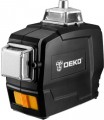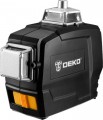Measurement range (with receiver)
The longest measurement range provided by a laser level (see “Type”) when using a special receiver with a photocell.
Thanks to its sensitivity, such a receiver is able to respond even to a weak laser beam, the mark from which is no longer visible to the naked eye; At the same time, the area of the photocell is quite large, and special indicators make it possible to determine the exact position of the mark. Among other things, this significantly expands the range of action of the level - the measurement range with a receiver is usually several times greater than without it. On the other hand, such equipment inevitably affects the overall cost of the device; and in some models the receiver
is not included in the package at all; it must be purchased separately. However, the second option also has its advantages: you do not need to immediately pay for an additional accessory, it can be purchased later, when a real need arises, while some models allow you to choose the optimal receiver model from several options at your discretion.
Note that the receiver can be useful not only for increasing range; These points are described in detail in paragraph “Included parts”.
Accuracy
Accuracy is described as the maximum deviation from the true value of the measured parameter, which the device can give if all the rules for its operation and the corresponding measurements are observed. In both rangefinders and levels, this parameter is usually designated for a certain distance — for example, 3 mm at 30 m; but even for one manufacturer, these "control" distances may be different. Therefore, in our catalog, the accuracy of all devices is recalculated for 1 m distance; with such a record, for the example above, it will be 3/30 \u003d 0.1 mm / m. This makes it easier to compare different models with each other.
It is also worth mentioning that the meaning of the "accuracy" parameter for different types of measuring instruments (see "Type") will be different. For optical levels, it is described in the "SKP" paragraph above. For laser levels of all types, accuracy is the maximum deviation of the mark from the true horizontal (or vertical, if such a function is provided), and for the horizontal, we can talk about both moving the mark up / down and turning it. In rangefinders, this characteristic describes the maximum difference (both in "plus" and "minus") between the readings of the device and the actual distance to the object.
Anyway, the smaller the error, the better; on the other hand, accuracy significantly affects the price of the device. Therefore, it is necessary to choose a specific model for this parameter, taking into account the...specifics of the planned work. For example, for a relatively simple repair in a residential apartment, a high-precision tool is unlikely to be required; and recommendations for more complex tasks can be found in specialized sources, ranging from expert advice to official instructions.
Self-leveling angle
The maximum deviation from the horizontal position that the device is able to correct "by its own means".
Self-leveling in itself greatly simplifies the installation and initial calibration of levels (see "Type"), which often (and for optical models — mandatory) need to be set horizontally to work. With this function, it is enough to install the device more or less evenly (in many models, special devices are provided for this, such as round levels) — and fine tuning in the longitudinal and transverse planes will be carried out automatically. And the limits of self-leveling are usually indicated for both planes; the higher this indicator, the easier the device is to install, the less demanding it is to the initial placement. In some models, this figure can reach 6 – 8 °.
Leveling time
Approximate time it takes for the self-levelling mechanism to bring the level to a perfectly level position.
For more information on such a mechanism, see Self-Level Limits. And the actual time of its alignment directly depends on the actual deviation of the device from the horizontal. Therefore, in the characteristics, usually, the maximum alignment time is given — that is, for the situation when in the initial position the device is tilted to the maximum angle along both axes, longitudinal and transverse. Since the levels are far from being installed in this position, in fact the speed of bringing to the horizontal is often higher than the claimed one. Nevertheless, it makes sense to evaluate different models precisely according to the figures stated in the characteristics — they allow you to estimate the maximum amount of time that will have to be spent on alignment after the next movement of the device. As for specific indicators, they can vary from 1.5 – 2 s to 30 s.
Theoretically, the shorter the alignment time, the better, especially if there are large volumes of work ahead with frequent movements from place to place. However, in fact, when comparing different models, it is worth considering other points. First, we reiterate that the rate of leveling is highly dependent on the leveling limits; after all, the greater the deviation angles, the more time it usually takes for the mechanism to return the level to the horizontal. So, to directly compare w...ith each other in terms of the speed of self-leveling, it is mainly those devices in which the permissible deviation angles are the same or differ slightly. Secondly, when choosing, it is worth considering the specifics of the proposed work. So, if the device is to be used frequently on very uneven surfaces, then, for example, a model with a leveling time of 20 s and self-levelling limits of 6 ° will be a more reasonable choice than a device with a time of 5 s and limits of 2 °, since in In the second case, a lot of time will be spent on the initial (manual) installation of the device. And for more or less even horizontal planes, on the contrary, a faster device may be the best option.
Operating temperature
The temperature range at which the device is guaranteed to work for a sufficiently long time without failures, breakdowns and exceeding the measurement error specified in the characteristics. Note that we are talking primarily about the temperature of the device case, and it depends not only on the ambient temperature — for example, a tool left in the sun can overheat even in fairly cool weather.
In general, you should pay attention to this parameter when you are looking for a model for working outdoors, in unheated rooms and other places with conditions that are significantly different from indoor ones; in the first case, it makes sense to also make sure that there is dust and water protection (see "Protection class"). On the other hand, even relatively simple and "myopic" levels / rangefinders usually tolerate both heat and cold quite well.
Diode emission
The wavelength of the radiation emitted by the LED of the level or rangefinder; this parameter determines primarily the colour of the laser beam. The most widespread in modern models are LEDs with a wavelength of about 635 nm — at a relatively low cost, they provide bright red radiation, giving a well-visible projection. There are also green lasers, usually at 532 nm — the marks from them are even better visible, but such LEDs are quite expensive and rarely used. And radiation with a wave longer than 780 nm belongs to the infrared spectrum. Such a laser is invisible to the naked eye and is poorly suited for leveling, but it can be used in rangefinders — of course, with a viewfinder (see "Type" for more details).
Spirit level
Level based on a spirit capsule (or several such capsules) built into the body of the instrument.
Such a device allows you to control the position of the device — namely, to check whether it is set horizontally; however, some models also provide levels for the vertical position, and sometimes even for tilting at 45 ° or another angle. But the specific purpose
of the spirit level may be different, depending on the type and general level of the device. The most popular option is a preliminary, rough installation of the laser level in the horizontal: the initial adjustment is carried out manually using a level, and after that the built-in self-leveling mechanism is activated. In simple and inexpensive household levels where high accuracy is not required, the spirit chamber may even be the only way to set it to the desired position; and some of these devices can also be used as full-fledged building levels.
In box
—
holder. Devices for fixing the level / range finder on various surfaces. Such a device differs from a tripod primarily in its small size — within a couple of tens of centimeters. On the other hand, most holders allow you to install the device not only on horizontal, but also on vertical surfaces — for example, walls (and some are exclusively wall-mounted). Anyway, this function greatly expands the installation possibilities.
—
Receiver. laser radiation supplied with the device. This device is usually equipped with laser levels, less often with rangefinders, and it is not required at all for optical instruments. The main purpose of the receiver is situations where the laser mark is not visible to the naked eye — for example, at a long distance or in bright light. More details on the features of its application are described above in the paragraph “Measurement range (with receiver)”.
—
Tripod. Most modern instruments have a standard size thread and can be used with any suitable tripod. On the other hand, a complete tripod is most often specially designed for a certain model and optimally matches it in terms of general characteristics. In addition, this configuration option relieves you of the need to look for and purchase a suitable tripod yourself.
—
Case / case. The main function of these devices is to protect
...the device from bumps, scratches, dirt, temperature changes and other adverse effects; for this, of course, improvised means can also be used, but specialized protection is usually both more convenient and more reliable. In addition, almost all cases and most covers greatly simplify the transportation of the tool — in particular, due to the fact that they can also be used for complete accessories.
— Remote control. Among rangefinders and optical levels, this function is practically not found, because. working with them involves the constant stay of the device in the hands of the operator. But for laser levels that require you to regularly move from the device to the surface to be marked and back, the remote control can be a very useful addition — due to the fact that it minimizes such movements. For example, after marking the "front of work" on the wall according to the projection from the level, you do not have to approach the device to turn it off — just give a command from the remote control. At short distances, the savings in time and effort may not be so obvious, but over large areas, they can become quite noticeable.
